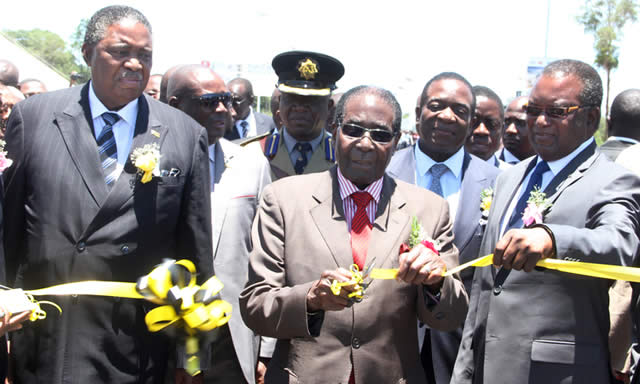SPECTRUM: Turning corruption into a culture


President Mugabe cuts the ribbon officially opening the Harare International Airport Road flanked by his deputies Cdes Emmerson Mnangagwa and Phelekezela Mphoko (left), Transport and Infrastructural Development Minister Joram Gumbo and other dignitaries in Harare yesterday. — (Picture by Justin Mutenda)
Joram Nyathi
ONE of the easiest ways to inflame people’s emotions and give political ammunition to the opposition MDC-T is to talk about Operation Murambatsvina. That is why it is not a favourite topic of Zanu-PF, yet it would appear MDC-T dominated councils always provide a fertile ground for the sprouting of illegal urban squatters and the need for regular Murambatsvina-style operations.
That operation in the winter of 2005 reportedly affected about 2,4 million people. Churches, non-governmental organisations and opposition parties were furious about the alleged violation of human rights. Opposition politicians claimed Murambatsvina was targeted at their support base given the voting patterns since 2000.
Whether there were hidden motives or not for that government operation, the official line is that Murambatsvina was meant to clear Zimbabwe’s urban areas of illegal settlements, commercial activities and to prevent the spread of deadly communicable diseases such as cholera, and police later said only about 120,000 people were affected.
Whatever the political arguments, with hindsight, what cannot be disputed is that government acted with uncanny prescience in launching Operation Murambatsvina given the devastating cholera epidemic which began in August 2008 chiefly in Harare’s slum areas. It left more than 4,200 people dead from almost 20,000 reported cases.
The cause of the outbreak was lack of clean drinking water due to general contamination from sewage. Overcrowding, which Operation Murambatsvina had sought to address three years earlier in 2005, had slowly returned. What is still scary to imagine is just what could have happened had the cholera outbreak occurred before Murambatsvina?
Murambatsvina adverts to a major national crisis which has never been addressed holistically since independence in 1980. Over the years government has launched housing schemes and allowed the proliferation of self-help housing projects or cooperatives, to allow individuals to save towards their residential accommodation. This process has never been able to match the flood of the unemployed seeking better opportunities in urban areas. A people’s government cannot be seen to want to restrict people’s movement without appearing to justify the colonial policies of the settler minority government.
Of course government tried to stem this urban tide by establishing growth points in the 1980s which would form a nucleus for the urbanisation of rural areas. These were duly supported with electricity under the Rural Electrification Agency, which is still extant.
But the idea of growth points was to prove unsustainable as the economy shrank drastically with the launch of Esap in the early 1990s. Most of the settlements were abandoned or the owners went bankrupt for lack of markets as thousands of workers were laid off under Esap’s austerity dictates.
Slowly but with greater momentum, the allure of the cities set in once again at a time government was allocating less and less towards social investment, more specifically, residential accommodation.
The few apartments built each year were quickly taken up, unfortunately, as it later emerged, often by people who already owned houses in town.
They could lease these apartments, give to relatives or girlfriends.
That experience sowed the seed of what would today be called “land barons”, people who used names of political parties or politicians to illegally acquire land, illegally subdivide it, illegally sell it to unsuspecting home seekers. It is a problem which has dogged Harare for a long time and doesn’t appear to be anywhere near a quick resolution.
So it was that President Mugabe had a face to face encounter with the phenomenon this week in the most unlikely of places — just outside Harare International Airport. The occasion was the opening of the first phase of Harare International Airport Road. When the President lifted his eyes, he noticed that what used to be dense forests to the east of the road was now open space with a sprouting mushroom of slum dwellings. This went by the appellation Nyikavanhu Housing Cooperative.
Noble endeavour indeed, but it was within the Harare International Airport expansion zone. Ministers knew it. So it wasn’t completely “illegal”.
The legislator for the area, Shadreck Mashayamombe, whom I know personally from another life at Jomic, said the slum dwellers had “settled themselves on that land in 2000” and that some of them refused to move when government offered them alternative land at Retreat Farm in 2013.
The cooperative was not “illegal”, according to some of the residents. One claimed that they were given “an offer letter” as Nyikavanhu Housing Cooperative in 2006. But it gets worse. Jena was forthright. He told reporters that the cooperative was in possession of an offer letter from the Civil Aviation Authority of Zimbabwe. It “cleared” them to build houses. It is a government agency, and it should know better than anyone else about plans for the expansion of the Harare International Airport.
“We’ve all the paperwork to build houses here under Arlington subdivision E,” protested Jena. “The subdivision is for 500 stands measuring 2,000 square metres.”
President Mugabe was clear. This was an area reserved for the expansion of Harare International Airport, it could not double as a residential area.
The dangers are pretty obvious given the mishaps often associated with aircraft landing.
So Cde Mashayamombe made a commitment to have the residents of Arlington subdivision E moved out in 14 days. It is another Murambatsvina coinciding with the rainy season. But that is not the main issue.
Zimbabweans have over the years turned lawlessness and corruption into a national culture. There is Caledonia, there is Hatcliffe. There are numerous other such settlements scattered across Harare and Chitungwiza where there is neither water nor sewer reticulation. There are no roads, there are no approved building plans. These are typical squatter settlements where people dig pit latrines and water wells side by side. The rains come, soak the earth and make a fine mix for a catastrophic cholera brew.
What is most worrisome is that out of this chaos, so-called land barons appear to make money and when the law visits the poor later in life, those who sold them the land can’t be located. They invariably make their hay while the sun shines, not so those unfortunate beneficiaries who must now contemplate an uncertain future in the middle of a summer season, no matter how patchy the rains. Then the money and time wasted in setting up those structures!
In summary, our national housing policy has never been accommodating to the poor, from official specifications for buildings to the purchase value. Financial institutions have been elitist in their programmes, never mind the empty claims that they hold the money in trust.
Despite government being ready to provide farms for residential accommodation to local authorities, the latter have demonstrated to be the least innovative, preferring instead to get into land deals with rich private individuals or so-called private developers who charge an arm and a leg for a basic house.
Which means every so often for the foreseeable future, we must look forward to a Murambatsvina operation.
From an aesthetic side, President Mugabe raised another compelling point. How do you allow an unplanned settlement next to the highway from the capital city’s biggest airport? Is that the picture we want to denote to curious visitors who have always denigrated the land reform programme?
For even the most sympathetic and charitable observer must wonder loudly; if this is what they can tolerate at their national airport, what must the situation be like beyond the sight of tourists? We are just too eager to annoy even those on whose sympathy we must bank in this hostile world!
Does the President have to personally move around the city pointing out illegal settlements to professional town planners?











Comments